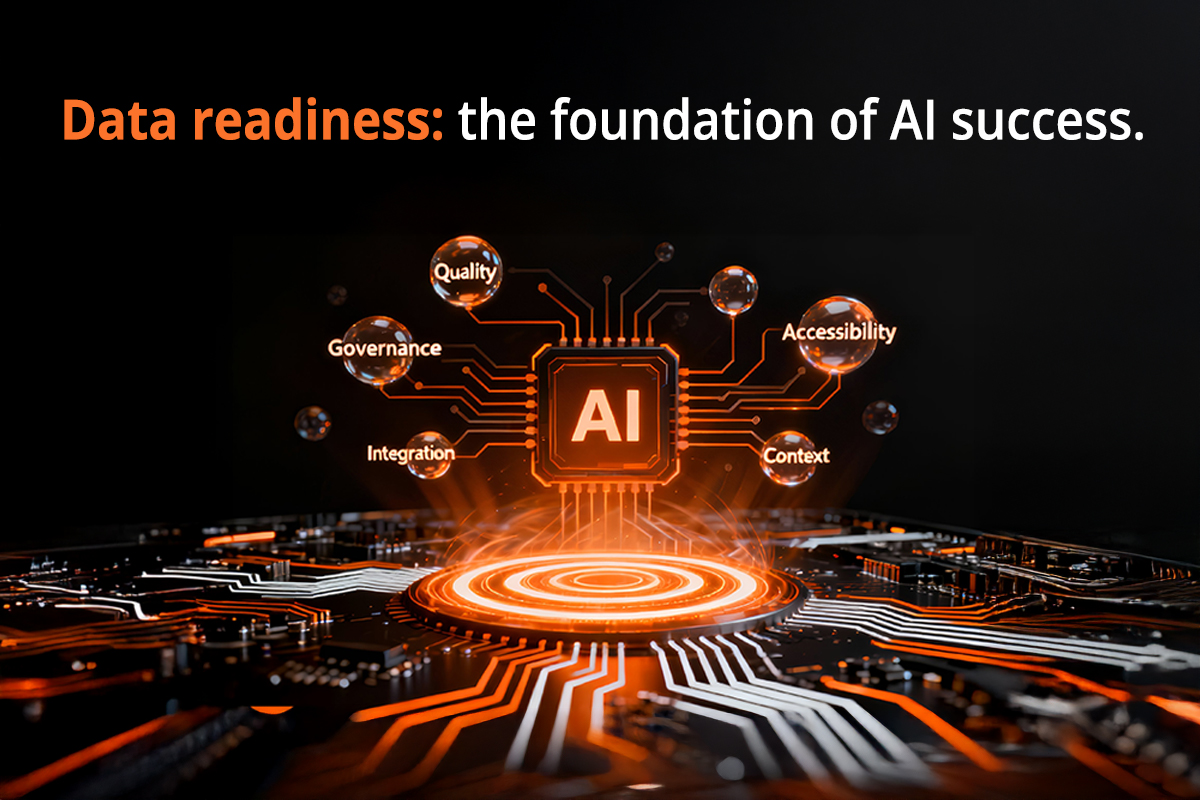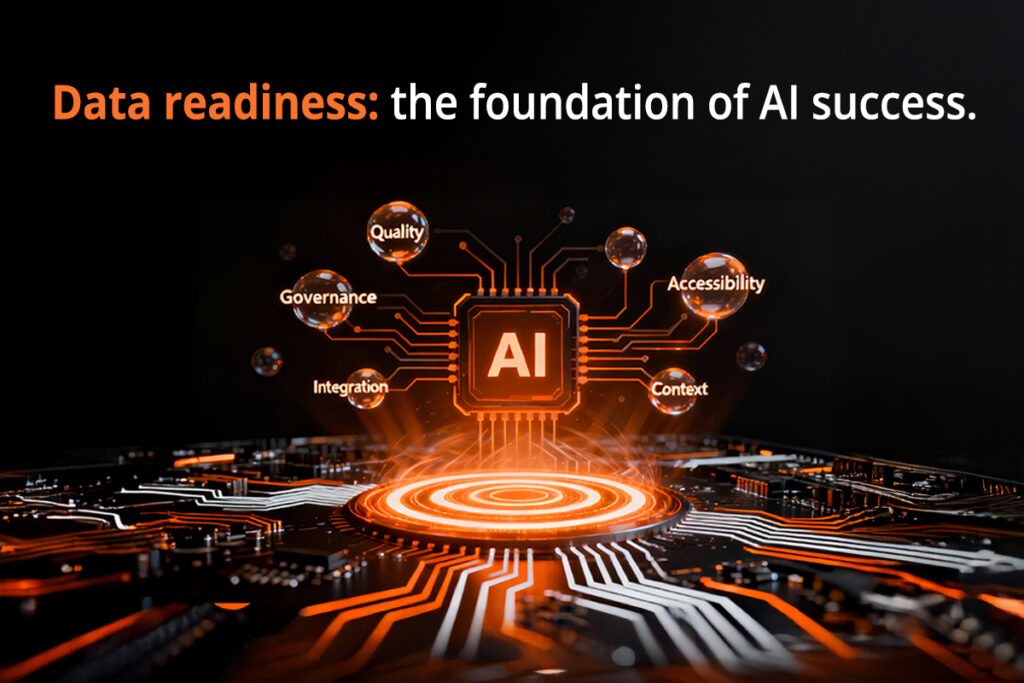

Let’s be honest: when your company fixes its focus on AI, it’s natural to get thrilled about the forecasts, algorithms, and appealing dashboards. However, what no one discusses with you directly is that almost 80% of the work in any AI project is irrelevant to artificial intelligence itself. It’s all about your data, specifically making it ready.
And if your data isn’t ready, your AI initiative won’t last long. AI adoption is no longer just a futuristic goal but a competitive necessity in the modern digital landscape. Whether you're forecasting demand, automating customer service, or detecting anomalies, success does not rely only on powerful models but on one significant groundwork, data readiness.
But what exactly does the term “data-ready” indicate? Why is data readiness so crucial, and what measures can you take to assess your business’s position??
This blog clarifies everything. You’ll understand what data readiness is, what pillars support it, the consequences of skipping it, and how you can evaluate your organisation’s readiness to fuel reliable, scalable AI.
What Does Data Readiness Refer To?
The groundwork of “data readiness” refers to how equipped your data is in terms of its application in AI and machine learning models. It’s about having data that is not only available but also accurate, structured, governed, and accessible, which indicates that it’s ready to support precise and impactful AI outcomes.
The assumption is that if you have loads of data, you’re ready to move. However, having raw data doesn’t necessarily mean having AI-ready data. Consider it this way:
- Raw data is similar to crude oil: Precious but non-functional until refined.
- AI-ready data is the refined fuel: Organised, consistent, and all set to drive your AI engine.
Also, don’t mix up data availability with data usability. Just because you have data accessibility doesn’t mean it’s free from duplication, is in the right format, or is aligned across systems.
Another key factor is that data readiness is not just a matter of technology but also an organisational alignment that includes the people, policies, and processes under which data is managed, maintained, and accessed. Even the best data infrastructure can fall behind without this structure.
Why Data Readiness is Vital for AI Accomplishment
Consider spending time and effort on developing an AI solution, only to discover that your data is inadequate, unrelated, or inconsistent. It happens more frequently than you’d imagine and is the reason behind the failure of so many AI projects before they ever deliver value. Your incomplete data can directly impact:
- Training accuracy: Your model learns from the data you feed it, and if that is flawed, your predictions will also be flawed.
- Model bias: Unfinished or unbalanced datasets can unintentionally strengthen damaging biases.
- Deployment timelines: Every interruption in fixing data issues pushes back your go-live date, adding more expenses.
On the other hand, with ready data, you boost development, reduce rework, and enhance your AI’s performance from day one. So, if you’re serious about AI, investing in data readiness is no longer an option but a strategy.
The Significant Factors of Data Readiness
Your organisation has to aim for five foundational pillars to become entirely AI-ready. Let’s dig in.
- Data Quality
The quality of your AI reflects the exact data it learns from. You must ensure:
- Accuracy: Is the data precise and consistent?
- Completeness: Are you taking the complete scenario or just parts of it?
- Consistency: Are formats, values, and logic standardised across systems?
Before feeding data into any AI model, it's essential to handle missing values, identify outliers, and eliminate duplication, as these are non-negotiable steps.
- Data Governance
AI projects demand reliability, transparency, and authority, where a strong data governance ensures:
- Clear ownership of datasets
- Defined access controls and user permissions
- Reliable data lineage to help you recognize the source of your data
And if your data includes personal or sensitive information, you must also align with regulatory compliance, whether it’s GDPR, HIPAA, or industry-specific standards. Non-compliance can result in shutting down your AI project before it starts.
- Data Integration
AI succeeds in holistic insights, which often demand a combined dataset from various sources, including ERP, cloud applications, CRM, or even IoT devices.
You won’t get the full picture if your data lives in silos. The integration allows for:
- Consolidated views across product, customer, or active data
- Removal of duplicate entries
- Seamless data flow between systems
Getting this right enables richer, more precise AI outcomes.
- Metadata & Context
Contextless data has no meaning. AI demands understanding much more than just value.Metadata such as descriptions, labels, timestamps, and tags helps your models understand the data properly.
It also supports explainability, which is important for regulated industries where AI decisions must be correct. Never ignore the role of business context, as it’s something that connects your data to practical scenarios and makes AI outputs actionable.
- Infrastructure & Accessibility
Lastly, your data needs to be stored and delivered through a setup that’s both scalable and real-time ready. This involves:
- Cloud-native storage
- Data pipelines that feed transparent, efficient data into AI tools
- MLOps frameworks that standardise data movement from collection to modelling to deployment
Even the best models will underperform if your systems fail to deliver accurate data to the right people at the right time.
Assessing Your Organisation’s Data Readiness
So, where do you stand?
Here are a few significant questions to help evaluate your readiness:
- Do you have transparent, reliable, and well-documented data?
- Do you have data ownership and transparent data access policies?
- Are your systems interlinked, or is your data stuck in silos?
While you don’t have to overhaul everything at a time, a phased strategy helps. Begin with high-impact datasets, enhance visibility and governance, and scale from there.
Think of applying a data maturity model or a readiness checklist to support your assessment, even an informal one, that can focus on lacks and opportunities.
Common Mistakes to Avoid
When organisations flash into AI, a few common mistakes appear in a loop. Avoid these, and you’ll be leading the competition:
- Skipping groundwork: Jumping directly into model building before sorting out your data
- Underestimating the effort: Thinking a one-time ETL script is sufficient
- Lack of collaboration: When data teams and business users don’t match, objectives and insights lack coordination
- Short-term thinking: Treating AI as a project, not a skill that requires lasting data investment
Conclusion
The fact is AI is only as smart as your data allows it to be. If your data is unorganised, distributed, or inaccessible, your AI won’t deliver the expected value. But if your data is transparent, relevant, and context-rich, you set the stage for intelligent systems that are helpful.
Data readiness isn’t a checkbox to tick but a strategic skill. It demands communication between processes, people, and platforms. And it pays off at every stage of your AI journey. So what’s your next move?
Start by taking stock, audit your key data sources, notice gaps in ownership or structure, and commit to refining one layer at a time. Want to understand your organisation’s position on the data readiness scale? Contact our data strategy experts for a free consultation.
